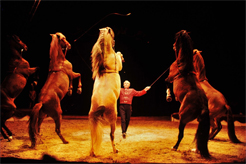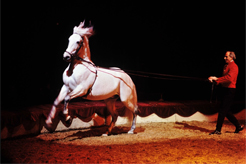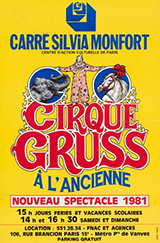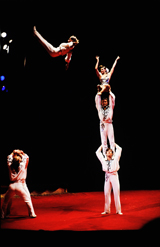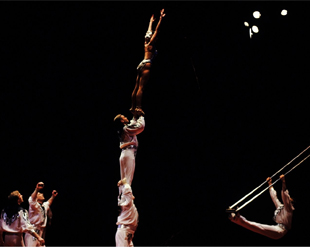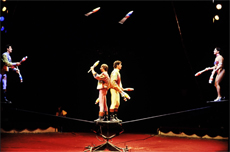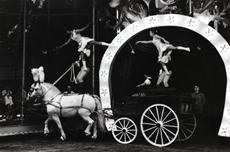by Pascal Jacob
Founded in May 1974 by the actress Silvia Monfort and the horseman Alexis Gruss, the Cirque à l’Ancienne is considered one of the pioneers of the revival of circus arts that began in the late 1960s. Dreamt up on the occasion of an exhibition at the Musée en herbe in the Jardin d’Acclimatation, it was so successful that the partners all decided to continue with the venture.
The troupe – in the Molièresque sense of the term, no doubt one of the reasons behind the extraordinary cohesion felt in the ring – was based between the columns of the peristyle at the Hôtel Salé in the Marais, between the trees of the Square Chautemps, before settling for several years in the former Vaugirard slaughterhouses. The founding principle swung between a free recreation of nineteenth-century equestrian and acrobatic routines, inspired in particular by a careful reading of prints of the time, and capitalising on the expertise of every member of the circus family. Alexis Gruss, his father André, wife Gipsy, sister Martine, brother Patrick and sister Bella provided the first framework for the Cirque à l’Ancienne, an art form based on classical performance codes, but rooted in its time, affirming the simplicity of its costumes and the purity of its gestures as a reappropriation of the elegance and virtuosity of its origins, assumed as a form of modernity.
The Cirque à l’Ancienne brought about a profound shift in style away from the so-called traditional circus of the 1970s, in particular through the predominance of equestrian acts, singularly forgotten by the majority of companies performing across France at that time. By placing horses right at the heart of their concerns, the Gruss family heralded the return to grace of the circus’s most beautiful conquest, prefiguring the Théâtre Équestre Zingaro and the Théâtre du Centaure, founded in 1986 and 1989 respectively. Horses lie at the very origins of the ring and contributed in large part to influencing the evolution of forms, show registers, repertoires and the language of the circus throughout the nineteenth century. By building the framework of every show performed over forty years around this emblematic animal, the Gruss family claimed an attachment to the history and meaning of the circus since as far back as 1768. They also combined the mastery of their art with an aesthetic concept and technique that resonated like a manifesto in favour of a circus detached from all the rubbish that had hampered it for nearly a century. Alexis Gruss wasted no time in choosing an annual show based on a theme that allowed him to develop new routines by gradually involving his children and students from the École au Carré, also founded in 1974. Paris-Pékin, De Lautrec à Picasso, Banquistes and Gipsy were just some of the ways to breathe life back into a slightly vague memory and an exploration of new territories in which the integration of stage elements and particular attention to costume design were key.
In the early 1980s, Alexis Gruss called upon on fashion designer Jean Eden to create the costumes. It was he who designed the outfits for Martine Gruss for the recreation of La Poste, an act dreamt up by horseman Andrew Ducrow in 1827, and for Stephan Gruss for his Mongolian archer act on a galloping horse. When the Cirque à l’Ancienne became the Cirque National in 1982, Alexis Gruss invited the set and costume designer Yannis Kokkos to create costumes for three of his shows. By combining influences in this way, Alexis Gruss aligned himself with the concerns of his contemporaries, but retained the principle of juxtaposing acts to define his identity.
With a stable of fifty horses, Alexis Gruss developed his shows around his animals, their ability to learn new skills to create veritable tableaux vivants, magnificent carousels and remarkable freedoms, exploring the basics, evolutions and changes in a repertoire coded throughout the nineteenth century, by constantly adapting them to the framework of his compositions.




